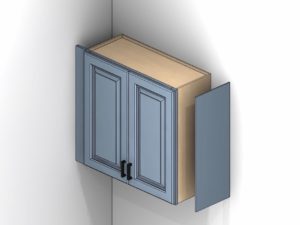Molding is an important detail and finishing touch for kitchen cabinetry. Molding improves the overall effect of the kitchen by creating a custom and polished look. There are several different kinds of molding options available. Depending on your design preferences and selected cabinets the options are almost limitless. Here are some of the most common molding options available for your kitchen cabinets.
Our Mission
Crown Molding is used to finish the tops of tall and wall cabinets. All Cabinets.com cabinet door styles are Full Overlay – this means the doors overlap the front face frame of the cabinet box, leaving only a small amount visible. Since this visible reveal will vary depending on the specific cabinet line you choose, cabinets that have smaller reveals may require the Crown Molding to be installed on top of the cabinet frame instead of to the face, secured with blocking from behind. Crown is available in various styles and sizes to accommodate different design styles and ceiling heights.
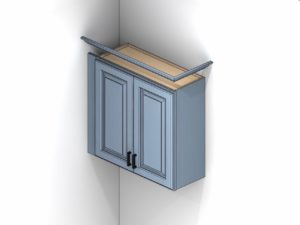

Starter/Riser Molding
A Starter or Riser Molding is used as a mounting frame for Crown Molding in order to increase the overall height of a Crown Molding assembly, or allow it to rise flush to the ceiling. Ceiling heights are variable and Crown Molding is rarely the exact height required to fit the overall space. A Starter or Riser Molding is mounted to the cabinet top in order to simulate an extension of the cabinet box, allowing the Crown Molding to be installed higher. Using a Starter or Riser Molding in conjunction with a Crown Molding also provides the ability to better disguise an uneven ceiling, as one end of the Crown Molding may be mounted higher or lower than the other end along the face of the Riser.
Light Rail Molding
Light Rail Molding is used to finish the bottom of wall cabinets. It can function as a trim to conceal under-cabinet lighting fixtures and provide a barrier from the light glare, or simply serve as a decorative enhancement. Light Rail Moldings are available in a variety of styles and sizes to accommodate different design styles. When selecting a Light Rail Molding, be mindful of the molding height to ensure the open space left after installation will accommodate any countertop appliances.
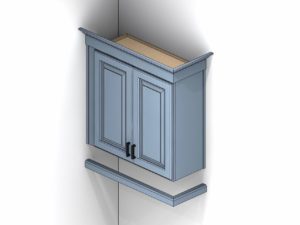

Base Molding
Base Molding is generally used to provide a decorative trim at the floor level of base cabinets by installing it with the profiled edge facing up. It completes the lower sections of panel skins used on islands and peninsulas to give them a more furniture-like feel. Installing the molding along the lower section of cabinet sides to the toe recess creates one continuous look. Base Molding can also be reversed (used with the profiled edge facing down) in higher areas where a wide decorative molding is desired. (See ‘Starter/Riser Molding’ below)
Fillers
Fillers are most commonly used to “fill” any gap or leftover space in a run of cabinetry by field-cutting them to the desired size. They can be used vertically to provide additional space between a cabinet and a wall in order to keep the edge of doors from binding into the wall, or to keep fully extended drawers from impacting close obstacles. They can be used horizontally as crown, light rail, or valance. They can also be used to add additional height and dimension as a riser molding (See ‘Starter/Riser Molding’ below). Fillers are available in widths of 3” and 6” in a variety of lengths to best accommodate their specific use with minimum waste.
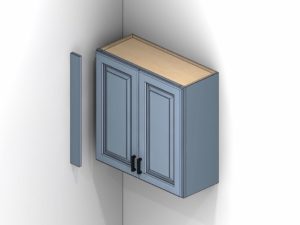
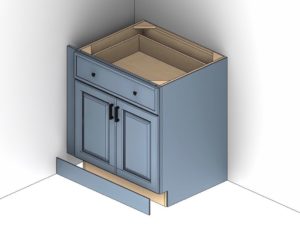
Toe Kick Molding
The purpose of a toe kick space is to create a recess for your feet, which allows you to stand closer to the countertop or workspace more comfortably. The toe kick stretcher attached to the cabinet is usually made of unfinished material. After installation, a finished Toe Kick Molding is applied to cover an entire run of unfinished toe space. Toe Kick Molding is a 96” long strip of finished covering that is field-cut and positioned in the recess to provide a continuous completed look to the cabinetry.
Scribe Molding
Scribe Molding is a thin piece of finished trim used to cover any areas that may have uneven gaps or raw edges visible once installation is complete. It is slightly flexible, allowing it to follow slight curvatures against walls, floors, or ceilings. It is typically used any place the straight edges of cabinetry visibly come into contact with a surface that is bowed or uneven. It is available in 96” lengths and must be field-cut to cover any visible gaps or seams against walls, floors, and ceilings up to ½” wide. It is also used to cap the cut, unfinished edge of a Toe Kick Molding or any other raw edge of material up to ¾” wide.
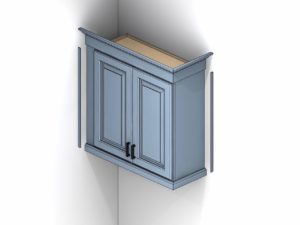
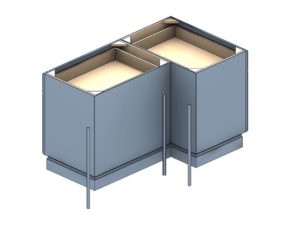
Corner Molding
Corner molding is used to cover an unfinished edge or a gap where two panels or pieces of material meet at a 90 degree angle. Outside Corner Molding is used to cap the raw edge of material visible on an exterior corner. Inside Corner Molding is used to cover any gaps where two pieces of material meet on an interior corner. They should be used in conjunction with any design that will require finished paneling on the back of a cabinet such as an island or peninsula.
Skin Panels
Skin Panels are 1/4” plywood with a matching finish on one side. They are available in a variety of sizes in order to provide finish options for different needs. Some cabinet lines have unfinished sides and will require a Skin Panel applied to all cabinet sides that will be visible after installation. These Skin Panels are available in specific sizes and are designed to fit on the side of a cabinet behind the face frame edge with no field-cuts required. Oversized Skin Panels, such as those used to finish the back of an island or to cover a stack of cabinetry, are larger and must be field-cut to the desired dimensions. When installing a Refrigerator End Panel Return against the flat edge of a countertop, a Tall Skin Panel Skin should be applied to the exposed side in order to provide a continuous flush surface against the straight edge of the counter.
